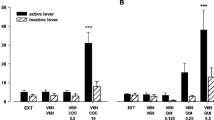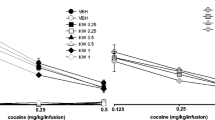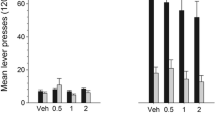Abstract
Several experiments investigated the involvement of D1 and D2 dopamine receptors in the ventral striatum in the control over behaviour by a conditioned reinforcer using an acquisition of new response procedure. Intra-accumbens infusion of either the D1 receptor antagonist, SCH 23390, or the D2 receptor antagonist, raclopride, completely blocked the potentiative effects of intra-accumbensd-amphetamine on responding with conditioned reinforcement and reduced responding to control levels. SCH 23390 was more potent than raclopride. At higher doses in the absence ofd-amphetamine, both antagonists also blocked the preference for responding on the lever producing the conditioned reinforcer. Intra-accumbens infusions of either the D1 receptor agonist, SKF 38393, or the D2/3 receptor agonist, LY 171555 (quinpirole), selectively potentiated responding on the lever producing the conditioned reinforcer. Various combined infusions of the D1 and D2 agonists in specific low doses had additive, but not synergistic, effects on responding with conditioned reinforcement. None of the drugs affected the drinking of water in deprived subjects when infused intra-accumbens. These results suggest that both D1 and D2 receptors in the nucleus accumbens are involved in mediating the effects of dopamine in potentiating the control over behaviour by conditioned reinforcers.
Similar content being viewed by others
References
Amalric M, Berhow M, Polis I, Koob GF (1990) Functional differences between D1 and D2 dopaminergic receptors in a conditioned motor task. Psychopharmacology 101:3
Beninger RJ (1991) D1 receptor involvement in reward-related learning. J Psychopharmacol 6:34–42
Beninger RJ, Hoffman DC, Mazurski EJ (1989) Receptor subtype-specific dopaminergic agents and conditioned behavior. Neurosci Biobehav Rev 13:113–122
Cador M, Taylor JR, Robbins TW (1991) Potentiation of the effects of reward-related stimuli by dopaminergic-dependent mechanisms in the nucleus accumbens. Psychopharmacology 104:377–385
Carr GD, Fibiger HC, Phillips AG (1989) Conditioned place preference as a measure of drug reward. In: Liebman JM, Cooper SJ (eds) Neuropharmacological basis of reward. Oxford University Press, Oxford, pp 264–319
Carlson JH, Bergstrom DA, Walters JR (1987) Stimulation of D-1 and D-2 dopamine receptors appears necessary for full expression of postsynaptic effects of dopamine agonists: a neurophysiological study. Brain Res 400:205–218
Chu B, Kelley AE (1992) Potentiation of reward-related responding by psychostimulant infusion into nucleus accumbens: role of dopamine receptor subtypes. Psychobiology (in press)
Clark D, White FJ (1987) Review: D1 dopamine receptor- the search for a function: a critical evaluation of the D1/D2 dopamine receptor classification and its functional implications. Synapse 1:347–388
Clifton PG, Rusk IN, Cooper SJ (1991) Effects of dopamine D1 and dopamine D2 antagonists on the free feeding and drinking patterns of rats. Behav Neurosci 105:272–281
Davis WM, Smith SG (1974) Behavioral control exerted by an amphetamine based conditioned reinforcer. In: Singh JM, Lal H (eds) Drug addiction, vol 3. Neurobiology and influences on behavior. Stratton Intercontinental Medical Book, New York, pp 209–249
Delfs JM, Kelley AE (1990) The role of D1 and D2 dopamine receptors in oral stereotypy induced by dopaminergic stimulation of the ventrolateral striatum. Neuroscience 39:59–67
Deutch AY, Cameron DS (1992) Pharmacological comparison of dopamine systems in the nucleus accumbens core and shell. Neuroscience 46:49–56
Dreher JK, Jackson DM (1989) Role of D1 and D2 dopamine receptors in mediating locomotor activity elicited from the nucleus accumbens of rats. Brain Res 487:267–277
Everitt BJ (1990) Sexual motivation: a neural and behavioural analysis of the mechanisms underlying appetitive and copulatory responses of male rats. Neurosci Biobehav Rev 14:217–232
Everitt BJ, Robbins TW (1992) Amygdala-ventral striatal interactions and reward-related processes. In: Aggleton JP (ed) The amygdala: neurobiological aspects of emotion, memory and mental dysfunction. Wiley, New York, pp 401–430
Everitt BJ, Cador M, Robbins TW (1989) Interactions between the amygdala and ventral striatum in stimulus-reward associations: studies using a second-order schedule of sexual reinforcement. Neuroscience 30:63–75
Gerfen CR (1992a) D1 and D2 dopamine receptor regulation of striatonigral and striatopallidal neurons. Semin Neurosci 4:109–118
Gerfen CR (1992b) The neostriatal mosaic: multiple levels of compartmental organization. TINS 15:133–139
Gerfen CR, Engber TM, Mahan LC, Susel Z, Chase TN, Monsma FJ, Jr, Sibley DR (1990) D1 and D2 dopamine receptor-regulated gene expression of striatonigral and striatopallidal neurons. Science 250:1429–1432
Groenewegen HJ, Meredith GE, Berendse HW, Voorn P, Wolters JG (1989) The compartmental organization of the ventral striatum in the rat. In: Grossman C, Sambrook A (eds) Neural basis for disorders in movement. Libbey, London, pp 45–54
Heimer L, Zahm DS, Churchill L, Kalivas PW, Wohltmann C (1991) Specificity in the projection patterns of accumbal core and shell in the rat. Neuroscience 41:89–125
Hoebel BG, Hernandez L (1989) Microdialysis studies of psychostimulants. NIDA Res Monogr 95:343–344
Johansson P, Levin E, Gunne L, Ellison G (1987) Opposite effects of a D1 and D2 agonist on oral movements in rats. Eur J Pharmacol 134:83–88
Jones GH, Marsden CA, Robbins TW (1991) Behavioural rigidity and rule-learning deficits following isolation-rearing in the rat: neurochemical correlates. Behav Brain Res 43:35–50
Kelley AE, Delfs JM, Chu B (1990) Neurotoxicity induced by the D1 agonist SKF 38393 following microinjection into rat brain. Brain Res 532:342–346
Kelly E, Nahorski SR (1986) Dopamine receptor-effector mechanisms. Rev Neurosci 1:35–55
Koob GF (1992) Dopamine, addiction and reward. Semin Neurosci 4:139–148
Lane DM (1981) Ageneral analysis of variance program for micro-computers. Behav Res Methods Instrum 13:214–263
Loh EA, Roberts DCS (1990) Break-points on a progressive ratio schedule reinforced by intravenous cocaine increase following depletion of forebrain serotonin. Psychopharmacology 101:262–266
Lyness WH, Friedle NM, Moore KE (1980) Increased self-administration ofd-amphetamine after destruction of 5-hydroxytryptaminergic neurons. Pharmacol Biochem Behav 12:937–941
Mackintosh, NJ (1974) The psychology of animal learning. Academic Press, London
Ohlstein EH, Berkowitz BA (1985) SCH 23390 and SKF 83566 are antagonists at vascular dopamine and serotonin receptors. Eur J Pharmacol 108:205–208
Pellegrino LJ, Pellegrino AS, Cushman AJ (1979) A stereotaxic atlas of the rat brain. Plenum Press, New York
Phillips AG, Fibiger HC (1990) Role of reward and enhancement of conditioned reward in persistence of responding for cocaine. Behav Pharmacol 1:269–282
Plaznik A, Stefanski R, Kostowski W (1989) Interaction between accumbens D1 and D2 receptors regulating rat locomotor activity. Psychopharmacology 99:558–562
Robbins TW (1976) Relationship between reward-enhancing and stereotypical effects of psychomotor stimulant drugs. Nature 264:57–59
Robbins TW, Everitt BJ (1992) Functions of dopamine in the dorsal and ventral striatum. Semin Neurosci 4:119–128
Robertson GS, Robertson HA (1987) D1 and D2 dopamine agonist synergism: separate sites of action? TJPS 8:295–299
Robbins TW, Cador M, Taylor JR, Everitt BJ (1989) Limbic-striatal interactions in reward-related processes. Neurosci Biobehav Rev 13:155–162
Salamone JD (1991) Behavioral pharmacology of dopamine systems: a new synthesis. In: Willner P, Scheel-Kruger J (eds) The mesolimbic dopamine system: from motivation to action. Wiley, Chichester, pp 519–613
Schwartz J-C, Giros B, Martres M-P, Sokoloff P (1992) The dopamine receptor family: molecular biology and pharmacology. Semin Neurosci 4:99–108
Setler PE, Sarav HM, Zirkle CL, Saunders HL (1978) The central effects of a novel dopamine agonist. Eur J Pharmacol 50:419–430
Stoof JC, Kebabian JW (1981) Opposing roles for D1 and D2 dopamine receptors in efflux of cAMP from rat neostriatum. Nature 294:366–368
Stoof JC, Kebabian JW (1984) Two dopamine receptors: biochemistry, physiology and pharmacology. Life Sci 35:2281–2296
Taylor JR, Robbins TW (1984) Enhanced behavioural control by conditioned reinforcers following microinjections ofd-amphetamine into the nucleus accumbens. Psychopharmacology 84:405–412
Taylor JR, Robbins TW (1986) 6-hydroxydopamine lesions of the nucleus accumbens, but not of the caudate nucleus, attenuate enhanced responding with reward-related stimuli produced by intra-accumbensd-amphetamine. Psychopharmacology 90:390–397
Waddington JL (1989) Functional interactions between D-1 and D-2 dopamine receptor systems: their role in the regulation of psychomotor behaviour, putative mechanisms and clinical relevance. J Psychopharmacol 3:54–63
Waddington JL, O'Boyle KM (1987) The D1 dopamine receptor and the search for its functional role: from neurochemistry to behaviour. Rev Neurosci 1:157–184
Walters JR, Bergstrom DA, Carlson JH (1986) Effects of D-1 and D-2 receptor stimulation on single unit activity in the substantia nigra and globus pallidus. In: Woodruff GN, Poat JA, Roberts PJ (eds) Dopamine systems and their regulation. Macmillan, London, pp 63–78
Winer, BJ (1971) Statistical principles in experimental design, 2nd edn. McGraw-Hill, New York
Yang CR, Mogenson GJ (1989) Ventral pallidal neuronal responses to dopamine receptor stimulation in the nucleus accumbens. Brain Res 489:237–246
Young AM, Herling S (1986) Drugs as reinforcers: studies in laboratory animals. In: Goldberg SR, Stolerman IP (eds) Behavioral analysis of drug dependence. Academic Press, Orlando, pp 9–68
Author information
Authors and Affiliations
Rights and permissions
About this article
Cite this article
Wolterink, G., Phillips, G., Cador, M. et al. Relative roles of ventral striatal D1 and D2 dopamine receptors in responding with conditioned reinforcement. Psychopharmacology 110, 355–364 (1993). https://doi.org/10.1007/BF02251293
Received:
Revised:
Issue Date:
DOI: https://doi.org/10.1007/BF02251293




